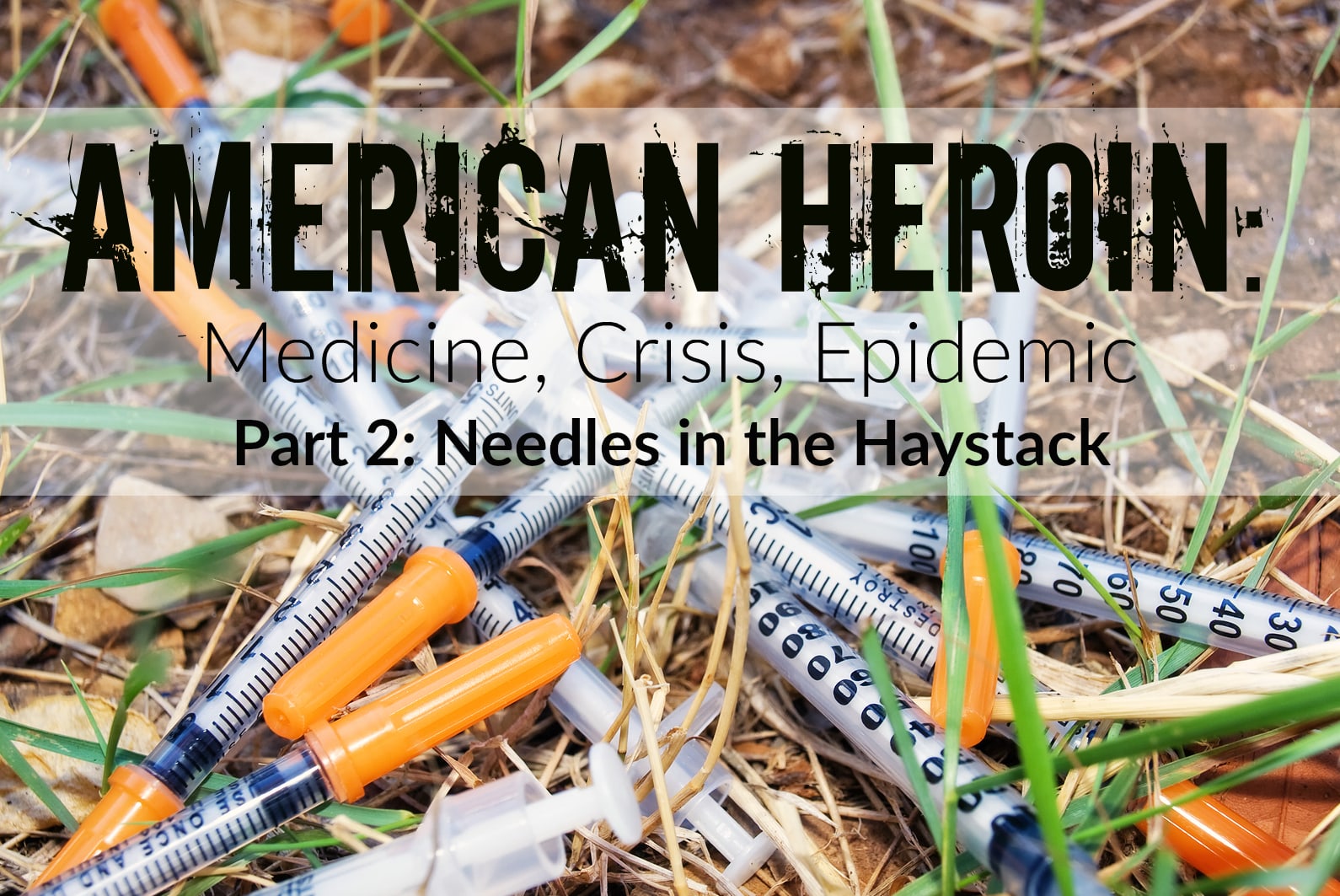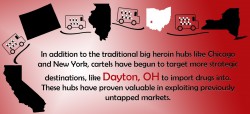From heroin’s origins to the pathways it takes to enter the country and the effect it has on cities and states around the U.S., this map is intended to give a broad stroke look at the challenge facing U.S. law enforcement officials and the human cost of this epidemic. Points of origin appear in red, border entry points in blue, cities in light green and states in dark green. Click on each bubble to learn more about that locale and how it relates to or is suffering from this epidemic.
Drug use and overdose statistics released by public health and law enforcement agencies paint a bleak picture when examining the current heroin crisis facing the country. But the sad truth about those numbers is that they oftentimes fail to convey the entire scope of the problem.
For example, the Centers for Disease Control and Prevention’s July 2015 edition of “Vital Signs” reported some alarming statistics, such as “the number of fatal heroin overdoses has quadrupled in the last decade.” However, the report collected data from specific demographics, while excluding the homeless, military personnel and prison inmates, all three of which have high rates of substance abuse in their populations.
To give an idea of the kind of numbers unaccounted for, the Substance Abuse and Mental Health Services Administration estimated in 2010 that on a given night, 34.7% of homeless adults who were provided shelter had chronic substance abuse issues.
Current military personnel are prescribed narcotic painkillers three times as often as civilians, according to a 2014 story from National Public Radio. In a report from the National Institute on Drug Abuse, 2008 saw military physicians write nearly 3.8 million prescriptions for painkillers.
Meanwhile, in prison, the drug trade runs almost as rampant as it does on the street. In a 2014 editorial for the Washington Post, addiction specialist and psychiatrist Dr. David Sack wrote that, “of the more than 2.3 million people in American prisons, more than 65% meet medical criteria for substance abuse and addiction.”
A realistic number of American heroin users is hard to come by, but according to a September 2015 article from the Washington Post, authorities estimate the number of heroin users in the United States could be as high as 1.5 million.
This statistical narrative quickly begins heading somewhere that law enforcement officers and rehab professionals know all too well. Heroin is no longer a low income, inner city problem, and the face of the addict is increasingly Caucasian.
Prior to the 1980s, whites and non-whites were equally represented among first time heroin users, but according to the CDC, 90% of first time heroin users over the last decade were white. The most significant increases in heroin use have been seen in communities that are middle class or wealthy, as the epidemic has enveloped those with private insurance and high incomes that were once addicted to prescription opioids.
Looking at the problem on a map, abuse has increased most noticeably in the northeast and Midwest since 2000. The problem has grown so significantly that Massachusetts has been forced to dump an additional $27 million into increasing its capacity to treat addicts after the state saw more than 1,000 heroin overdose deaths in 2014.
Did you miss it?: Part 1: A Nation in Pain
The Spread
Places like Chicago, New York and Los Angeles were once the hubs of distribution for heroin entering the United States. Suppliers’ ability to meet demand was largely dependent on getting the drug into the hands of street level gangs and have it distributed out from there. As a result, much of suburban America and rural areas never really saw the drug in large quantities.
But in recent years, Mexican and Colombian drug cartels have matured, taking a more sophisticated, almost corporate approach in terms of discipline, manufacturing and especially distribution. Their business models are no longer reliant on the importation of Afghan heroin, as they now manufacture the drug themselves. They’re producing it in large quantities and some cartels have successfully reformulated the drug to a refined powder that newcomers can smoke or snort. The absence of a needle in the arm has made heroin a more popular drug of choice than ever before.
With complete control of the supply of heroin, cartels are sending the drug over the border every way they can.
One kilo (roughly two pounds) of product can yield up to 30,000 hits of the drug, which are sold at an average price of $10 a hit on the street. Heroin is not only cheaper for the addict, it’s far more efficient for the dealer than the process of acquiring and reselling black market pharmaceuticals.
As a result of the sheer volume of product being supplied, the street price of heroin has remained cheap while the number of addicts has exploded.
According to a 2014 report from the Office of National Drug Control Policy, heroin seizures by local, state and federal authorities increased by 289% between 2007 and 2013. In total, 2013 saw 5,691 kilos of heroin seized across the United States.
In places like Montgomery County, Ohio (near Dayton), the number of overdose deaths has increased 225% since 2011. It is now among cities with the highest rate of fatal heroin overdose deaths in the nation.
Finding heroin in Dayton is simple according to recovered heroin user and Dayton native Jeremiah Hess.
[pullquote align=”full” cite=”” link=”” color=”#4DB2EC” class=”” size=””]“Money is the biggest thing. Once you have money, heroin is easy to get. It’s everywhere.”
– Jeremiah Hess, Recovered heroin user, Dayton, OH
[/pullquote]
That’s because Dayton is a target market. In addition to the traditional big heroin hubs like New York and Chicago, cartels now use strategic destinations, like Dayton, to import drugs into.
Smaller municipalities typically come with smaller police forces and are often wedged in geographic locations that offer connections to multiple cities and suburbs, as well as the predominantly white demographic that the drug has captured.
The cartels exploitation of these previously untapped or, for lack of a better term, under-served markets, has resulted in a multi-billion dollar industry that has cities like Nashville, Tenn. and Charlotte, N.C. in the East, or Salt Lake City, Denver and Portland, Ore. in the West, serving as hubs for heroin trafficking in the regions that surround them. States like Oklahoma, Kentucky and West Virginia have become lucrative stops along what a Washington Post article referred to as the cartel’s “farm to arm supply chain.”
Law Enforcement Challenges
Stopping the flow of heroin into the United States from Mexico is essentially impossible. With more than a million legal border crossings each year for legitimate business, shutting down the border is not a realistic option, as it would crush the economy of surrounding cities and towns and could seriously damage business in entire states.
But with all the innocent activity that surrounds the border, there is the criminal element operating in the shadows, or rather, in the spare tires, car door frames, gas tanks, luggage and personnel crossing the border.
Drug traffickers explore any and all avenues for getting product into the United States. A few common tricks traffickers often use include having someone ingest the drug for a pedestrian crossing, or using decoy cars covered in marijuana oil. This can lure the attention of dogs and border officers, who pull cars into inspection areas for fruitless searches, while other traffickers concealing heroin or methamphetamine are able to slip past distracted security and cross the border unnoticed.
After a successful crossing, the drugs are rapidly moved north to places like Chicago, a major distribution point for much of the Midwest. From there, the drugs make their way into the hands of street level dealers in cities like St. Louis, Milwaukee and Madison, Wis. – places where heroin abuse has quickly become widespread.
Distribution methods have also become more elaborate than the image you might have in mind of heroin sales; that of corner boys slinging little plastic bags of dope to lines of addicts outside housing projects and low income neighborhoods. While that still exists in some places, an increasing amount of what is sold now is done through dealer networks.
A 2015 article from the New York Times profiled a group known as the Xalisco Boys (pronounced ha-lees-ko), a reference to the county in Mexico where the group originated and manufactures heroin to this day. The Xalisco Boys use a popular method of delivery that is focused on providing heroin to their most common clientele in a way that is as fast and convenient as ordering pizza, which is why some have come to call it the “pizza delivery model.”
The group (sometimes referred to as a cell) arrives in a city and circulates a phone number to addicts outside of methadone clinics, even offering free samples around town. Then they wait. When buyers call, the cell leader, often in another city, answers acting as a dispatcher and directs them to an intersection or parking lot where they will meet a dealer.
Dealers drive around town in old cars wearing clothes that make them look like day laborers. They pack their mouths full of tiny balloons that hold the product and upon meeting the buyer, they simply spit out the requested number of bags. They bring plenty of water with them to drink in case they are pulled over by a police officer. This allows them to swallow the evidence with relative ease to avoid a trip to jail.
Drivers operate individually like entrepreneurs, oftentimes being recruited in Mexico and sent north where they can make as much as $500 for a week’s work. A single driver’s trip north of the border can earn up to $15,000 a day for a cell.
There is no set geographic area these cells are assigned to, so they seek out areas free of gangs ready for a turf war. They generally don’t carry guns and only sell to a certain demographic, mostly suburban whites who possess what the Times article referred to as the “trinity of American prosperity essential to the Xalisco system” – a cell phone to make contact, a car to meet in or get to a location with and a private bedroom in which to shoot up in, rather than shooting galleries that can become targets for police.
You Might Also Enjoy: Heroin Death Rates Increasing for Middle-Aged White Americans
“Guys from Xalisco figured out that what white people – especially middle-class white kids – want most is service, convenience. They didn’t want to go to skid row or some seedy dope house to buy their drugs. The drivers were prompt, they were polite, and they delivered,” author Sam Quinones wrote in his book, “Dreamland: The True Tale of America’s Opiate Epidemic.”
The U.S. Department of Justice reported that since its beginnings in the 1990s, the Xalisco dealer network has grown to span across the country, including Hawaii and Alaska.
They’re successful because they have avoided cities where the drug trade is generally controlled by gangs and the market saturated, but beyond that, their lack of violent behavior attracts less attention than other drug traffickers.
Their corporate style marketing effort isn’t built on just free samples and convenience either. Price breaks are not uncommon, and on occasion, customer survey calls are made in which operators ask about the politeness of the driver and the quality of the product. The organization of their supply chain and understanding of free market principles effects the operation from raw product to end user. It is just one more example of the creativity and initiative traffickers show in thwarting law enforcement.
For police, tracking operations like these is difficult. Phone systems and entire networks can be shut down almost instantaneously. The low profile buys are constantly happening on the move and the only really effective way to stop all of this from happening would be to arrest the creators of the supply chain coming from Mexico. But that would require the cooperation of Mexican authorities who are busy combating the extreme violence of other cartels and corruption within their own ranks.
In the end, one can close their eyes and throw a dart at a map of the United States, knowing they will almost certainly hit a location suffering from this latest epidemic of heroin use. From the hills of Eugene, Ore. to the rural farmlands of Vermont, the drug is now practically everywhere, dispensed by complex networks of traffickers and affiliate dealers who often come to know one another through the prison system meant to serve as a deterrent.
In recent weeks, presidential candidates have taken to their microphones to talk about addiction and this epidemic from both political and personal perspectives, but they’re far from the first politicians to look this problem in the eye.
Vermont governor Peter Shumlin famously addressed the state’s opiate problem during his 2014 State of the State address, in which he labelled Vermont’s roads as, “pipelines for heroin distributors coming up from New York City,” a distribution hub for much of the eastern seaboard. Shumlin also recognized the influx from other heroin satellite cities in upstate New York and Massachusetts. Due to the range of places the supply comes from, the volume of what is pouring in has shocked police.
[pullquote align=”full” cite=”” link=”” color=”#4DB2EC” class=”” size=””]“In the late 1990s, an enormous heroin bust for us would be 100 bags. Today, 5,000 is common.”
– Matthew Birmingham, commander of the Vermont Drug Task Force[/pullquote]
The supply shows no signs of slowing down. The 2015 World Drug Report of the United Nations Office on Drugs and Crime found that global poppy cultivation is at its highest since the 1930s, with authorities in the U.S. and Mexico estimating that opium production south of the border rose by 50% in 2014 alone.
The result has been increasing numbers of arrests and addicts that can’t find a bed at overwhelmed treatment centers around the country. According to the Rolling Stone article, 80% of Vermont’s prison population was in jail for heroin possession or was addicted to heroin while in prison. The state’s overdose death toll doubled between 2012 and 2013, while property crimes and home invasions also increased significantly.
For the dealers, Vermont is as much of a gold mine as any other state. Authorities estimate that $2 million worth of opiates are trafficked into the state each week, a staggering amount for a state with the second smallest population in the country.
Shortly after the governor’s address, Hollywood actor Philip Seymour Hoffman died of a heroin overdose, drawing national attention to the epidemic which has been haunting public health and law enforcement officials for years.
More Supply and More Dangerous
The purity of heroin has always been questionable. In the past, dealers cut the drug with caffeine, sugar, flour, starch, powdered milk, chalk or some other relatively harmless substance that weakened what the user got. Today, cartels are manufacturing something that makes it even more potent while allowing them to still increase their overall supply – fentanyl.
Fentanyl is a synthetic opiate 80 times more powerful than morphine. According to the Drug Enforcement Administration, authorities have raided several labs in Mexico that were receiving chemicals from China and Japan to create the drug. The DEA believes there are also labs inside the U.S. making fentanyl, according to a story by National Public Radio.
The inclusion of fentanyl only complicates things for the user. Either drug by itself is potent enough to kill someone if too much is consumed, but fentanyl effectively slows a user’s breathing, which makes it particularly dangerous when combined with another opiate such as heroin.
In Manatee County, Fla., this is of growing concern, as the deadly combination is not hard to come by. The county had more deaths due to heroin and fentanyl use than any other in the state in 2014. Statewide, there were 408 heroin related deaths that year and an additional 397 due to fentanyl use. For just the month of July in 2015, the county recorded 216 emergency calls for overdoses.
In an interview with NPR, firefighter Michael Dunn of Cedar Hammock Fire Rescue in Bradenton described Manatee County’s problem as being more of a war than an epidemic.
“The word epidemic gets used a lot. An epidemic to me is something that you sit back and watch, but this is more like a war because people are dying in our community,” Dunn said.
“In a typical day, we respond quite a few times to overdose victims and it’s been on a steady increase. Nobody is immune to overdose, but we’ve seen the biggest jump in 20-40-year olds when it comes to overdose cases. We’ve responded to cases in vehicles, bathroom stalls, in homes, just about anywhere.”
Despite the grim statistics and commonality of overdose cases, heroin and opiate use is still growing. Stricter enforcement on pharmaceuticals and increased efforts to find drugs at the border or in route to distribution points have made little difference, leading policy makers to wonder if America as a society is looking at this the wrong way.
Demand and the Four-Legged Stool
In 2011, Chicago had more than 25,000 heroin-related emergency room visits, more than any other city in the United States. In October of 2015, the inclusion of fentanyl in the Windy City’s heroin supply led to 74 overdoses in a 72-hour period, according to the Chicago Tribune.
While the criminal justice system has its role to play in combatting America’s drug problem, perceptions are shifting toward the view that the heroin epidemic is as much a public health crisis as it is a law enforcement issue, and the numbers support this thinking.
According to the New York Times, more than 8,250 people die from heroin each year in America. The number for prescription opioids is nearly double that, though it is falling due to the difficulty of getting pills.
Dan Duncan, Associate Executive Director of the National Council on Alcoholism & Drug Abuse for the St. Louis area told St. Louis Public Radio in March of 2014: “Until we start looking at the demand, not much is going to change. This country has a thirst to get high. The burden has mostly been on law enforcement, but it’s a four-legged stool. We have to do more in terms of community education, prevention and treatment.”
This is not to say that experts are advocating for the legalization or even decriminalization of drugs like heroin. In a 2015 Washington Post interview, Robert L. DuPont, M.D., Director of the National Institute on Drug Abuse (NIDA), expressed the importance of judicial consequence as it relates to society’s approach to addressing this epidemic.
“Do you think we should have treatment or prison?” he said. “That is a very false dichotomy when thinking about policy. The fact that a drug is illegal is very important in terms of prevention and treatment. I don’t think we’ve come anywhere near understanding how serious this is from a law enforcement or healthcare point of view. It’s devastating.”
Law enforcement officers battling this problem on the street everyday tend to agree. Help for addicts is difficult to come by with waiting lists at rehab facilities and public funding for prevention and treatment plans falling short. But if one thing has become clear, it’s that police and federal agencies can’t stop the epidemic on their own.
In the words of Bradenton Police Chief Michael Radzilowski in an interview with the Bradenton Herald in June of 2015: “We’re working hard on it, but we can’t arrest this problem away.”













